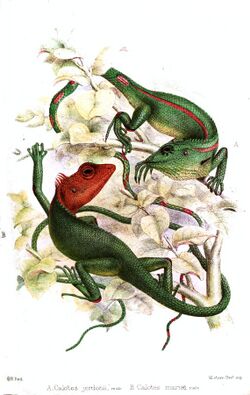Biology:Calotes maria
| Calotes maria | |
|---|---|

| |
| Scientific classification | |
| Domain: | Eukaryota |
| Kingdom: | Animalia |
| Phylum: | Chordata |
| Class: | Reptilia |
| Order: | Squamata |
| Suborder: | Iguania |
| Family: | Agamidae |
| Genus: | Calotes |
| Species: | C. maria
|
| Binomial name | |
| Calotes maria Gray, 1845[2]
| |
Calotes maria, called commonly the Khasi Hills forest lizard or Assam garden lizard, is a species of lizard in the family Agamidae. The species is endemic to South Asia.
Geographic range
C. maria is found in Northeast India (Khasi Hills in Assam, Meghalaya, and Mizoram)[1][3] and in Bhutan.[1] It is also reported from North-eastern Bangladesh.[citation needed]
Etymology
The specific name, maria, may be in honor of English conchologist Maria Emma Gray, the wife of John Edward Gray, the describer of this species.[3][4]
Morphology
The body is compressed, whereas the tail is almost round, slender, feebly compressed, and covered with keeled scales. The head is large. Both males and females have moderately developed nuchal and dorsal crests. The dorsal colour is green with red streaks and spots. The male develops a brilliant red colour in its head during the breeding season.[5]
Length: 120 mm (4.7 in) snout–vent length, 370 mm (14.6 in) tail length.[5]
Vernacular names
- English: Khasi Hills forest lizard,[1][3] Assam garden lizard[5]
- Bengali: খাসি রক্তচোষা, খাসিয়া গিরিগিটি (Khasia girigiti ) (proposed)
Behavior
C. maria is arboreal and diurnal.[5]
Habitat
C. maria occurs in forests, generally close to streams, at elevations of 122–1,500 m (400–4,921 ft) above sea level.[1]
Diet
C. maria is mainly insectivorous, i.e., feeds on insects.[5] It is diurnal in its foraging behavior, i.e., active during daylight hours.[6]
Reproduction
C. maria is oviparous.[3] Like other lizards, it is also polygynandrous and promiscuous and both the male and the female mate with several partners.[7]
Conservation
Despite its relatively small range, C. maria has been assessed as of "least concern" – it is facing no major threats affecting and is present in well-protected areas (Royal Manas National Park, Bhutan, and the adjacent Manas National Park, Assam; Lengteng Wildlife Sanctuary, Mizoram).[1] It is a rare species.[1][5]
References
- ↑ 1.0 1.1 1.2 1.3 1.4 1.5 1.6 Das, A. (2021). "Calotes maria". IUCN Red List of Threatened Species 2021: e.T202857A2757369. doi:10.2305/IUCN.UK.2021-3.RLTS.T202857A2757369.en. https://www.iucnredlist.org/species/202857/2757369. Retrieved 13 March 2022.
- ↑ Gray JE (1845). Catalogue of the Specimens of Lizards in the Collection of the British Museum. London: Trustees of the British Museum. (Edward Newman, printer). xxvii + 289 pp. (Calotes maria, new species, p. 243).
- ↑ 3.0 3.1 3.2 3.3 Calotes maria at the Reptarium.cz Reptile Database. Accessed 13 March 2022.
- ↑ Beolens, Bo; Watkins, Michael; Grayson, Michael (2011). The Eponym Dictionary of Reptiles. Baltimore: Johns Hopkins University Press. pp. xiii + 296 pp. ISBN 978-1-4214-0135-5. https://books.google.com/books?id=3ovZoFyLhzkC&pg=PT168.(Calotes maria, p. 168).
- ↑ 5.0 5.1 5.2 5.3 5.4 5.5 Tikader, B. K.; Sharma, R. C. (1992). Handbook India Lizards. Calcutta: Zoological Survey of India. p. 98. http://faunaofindia.nic.in/PDFVolumes/hpg/007/index.pdf.
- ↑ "Jerdon's Forest Lizard - Encyclopedia of Life". Eol.org. https://eol.org/pages/964155. Retrieved 2022-08-10.
- ↑ Bull, C.Michael (2000). "Monogamy in lizards". Behavioural Processes 51 (1–3): 7–20. doi:10.1016/S0376-6357(00)00115-7. PMID 11074308. https://www.researchgate.net/publication/222626002.
Further reading
- Boulenger GA (1885). Catalogue of the Lizards in the British Museum (Natural History). Second Edition. Volume I. ... Agamidæ. London: Trustees of the British Museum (Natural History). (Taylor and Francis, printers). xii + 436 pp. + Plates I-XXXII. (Calotes maria, pp. 322–323).
- Boulenger GA (1890). The Fauna of British India, Including Ceylon and Burma. Reptilia and Batrachia. London: Secretary of State for India in Council. (Taylor and Francis, printers). xviii + 541 pp. (Calotes maria, pp. 136–137).
- Günther ACLG (1864). The Reptiles of British India. London: The Ray Society. (Taylor and Francis, printers). xxvii + 452 pp. + Plates I-XXVI. (Calotes maria, pp. 144–145).
- Smith MA (1935). The Fauna of British India, Including Ceylon and Burma. Reptilia and Amphibia. Vol. II.—Sauria. London: Secretary of State for India in Council. (Taylor and Francis, printers). xiii + 440 pp. + Plate I + 2 maps. (Calotes maria, pp. 193–194).
Wikidata ☰ Q2934386 entry
 |


